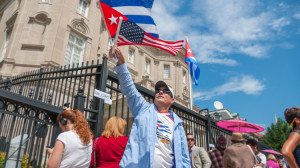
By: Helena Alvarez
American history reached a milestone on the afternoon of July 20th, 2015 as the foreign minister of Cuba, Bruno Rodríguez, raised his country’s flag at the much-anticipated ceremony of the Cuban embassy’s re-opening in Washington, D.C. The event marked the official restoration of fifty plus year-long severed ties between the United States (U.S.) and Cuba.
Since initiating his first term, President Obama’s stance towards Cuba and the Castro regime has been characterized as reconciliatory and somewhat controversial. The U.S.’s position has evolved into what the Obama administration has called an “Updated Policy Approach” that ultimately grounds itself in providing support for the Cuban people and seeking national security interests vis-à-vis other countries in the Western Hemisphere.
Although Obama’s announcement on the U.S. and Cuba’s rapprochement last December signified putting an end to “outdated” measures and policies that had been previously implemented, such as denominating Cuba a state sponsor of terrorism, efforts to normalize Cuban-American relations on the U.S. side have since been criticized by conservative leaders and the Cuban dissident community for various reasons. While the U.S. seeks to expand communication with Cuba, American ties to Venezuela have worsened (and continue to do so), as a result. And while the U.S. seeks to give greater recognition to Cuba as a sovereign state, it fails to acknowledge the Castro regime’s human rights record by doing so.
Now that the Cuban embassy in Washington, D.C. has re-opened, it is imperative to ask what we can expect to see as the “normalization process” continues.
As major components of the “Updated Policy Approach,” Obama has articulated several measures that are likely to follow the establishment of diplomatic relations (via the symbolic embassy re-openings in both countries’ capitals): “adjusting regulations to more effectively empower the Cuban people,” “facilitating an expansion of travel…,” “facilitating remittances to Cuba by U.S. persons,” and “initiating new efforts to increase Cubans’ access to communications and their ability to communicate freely.” (The White House, Office of the Press Secretary)
Even though normalization has since been heavily portrayed as “do-good,” both parties have plenty of demands to meet before Cuban-American ties can be fully restored, thus rendering the process a difficult one. While the Cuban government has long requested that the U.S. government return Guantánamo and lift the economic embargo that the Kennedy administration first set in 1962, the Obama administration hopes that reconciliation will lead to the secure return of American fugitives harbored in Cuba, the settling of outstanding legal claims to Americans for properties confiscated by the Castro regime, the free travel of U.S. diplomats to and throughout the island, the U.S.’s ability to compete in a foreign market and, finally, the securing of political freedoms for Cuban citizens.
Realistically, however, the raising of the Cuban flag at the newly designated embassy in Washington, D.C. is more symbolic than it is promising of better relations with our neighbor. A major embargo, like el bloqueo, cannot, first of all, be lifted right away because it would need Congress’ approval. If and by the time it is lifted, how much more time will it take for the average Cuban worker, who, according to a New York Times article, makes 20 USD a month, to increase his earnings and improve his own life?
Also, travel for American diplomats is likely to remain subject to restrictions after the re-establishment of ties. This was, in fact, manifested on Monday when a similar ceremony to the one in Washington, D.C. took place in La Havana with a significantly smaller, American diplomatic presence. Although Secretary of State Kerry plans to visit the island and carry out a more official re-opening ceremony (flag-raising and all) later this summer, Cuban spectators who attended Monday’s event in La Havana were left feeling quite disappointed. The scale of Monday’s event in Cuba leaves room for questioning both governments’ skepticism about having an American diplomatic presence on the island.
Finally and perhaps most importantly, there is also fear that Cuba’s human rights record may remain stagnant. If this does happen even after rapprochement, the U.S. will have essentially legitimized and condoned a repressive regime. Though having an embassy ideally protects the interests and values shared by a common people, the U.S.’s reconciliation with Cuba may carry out to mean that it is willing to engage with a regime that imprisons its own people for defending their voice.
The raising of the Cuban flag means nothing and everything at the same time.
